The UAE is more than just glitzy auto showrooms and luxury cars speeding down Sheikh Zayed Road. It is one of the busiest car export hubs in the world. Each month, thousands of vehicles leave UAE ports for destinations in Africa, Europe, Asia, and beyond, ranging from affordable used cars for sale to exotic supercars and used commercial vehicles.
The problem is that exporting a car involves more than just finding a buyer or choosing when to sell the vehicle. The shipping option you select has the power to make or break the transaction. It has an impact on your car's price, safety, and even how quickly it reaches its destination.
Container shipping and RoRo (roll-on/roll-off) are the two most popular shipping options in the United Arab Emirates. When you sell a car outside the UAE, each shipping method has its own pros and cons, and the best choice depends on your vehicle, budget, and your buyer’s needs. Let's break down the shipping methods for exporting cars.
Car Shipping from the UAE: An Overview

Understanding how the UAE's car export market operates is crucial before choosing the best method. The UAE is a major global hub for auto exports because of its favorable location, top-notch ports, and effective logistics. Thousands of vehicles leave its shores each year for locations across the globe. The major ports that handle vehicle exports are:
- The biggest port in the Middle East is Jebel Ali Port in Dubai, which offers easy access to international markets.
- Particularly for South Asia and Africa, Sharjah Port (also known as Khalid Port) is an affordable choice.
- Khalifa Port in Abu Dhabi has modern installations and increasing popularity for container trade.
Who Exports Cars from the UAE?
Auto dealers ship used cars in bulk to the Middle East, Eastern Europe, and Africa. Private buyers can move a single vehicle abroad, often after relocating. Collectors export luxury cars, vintage models, and rare classics.
Documents You'll Require
Since exporting a car involves a significant amount of paperwork, missing one form can cause delays. Documentation must be handled carefully to avoid any inconveniences. A standard list of required documents consists of:
- Export certificate from the RTA or relevant traffic authority.
- Customs clearance documents.
- Bill of lading from the shipping line.
- Proof of ownership and valid ID.
In Dubai, an export test certificate is also required before the RTA issues the final export certificate. This certificate ensures the vehicle is roadworthy at the time of its export. (Source: RTA Vehicle Technical Testing)
What is RoRo Shipping?
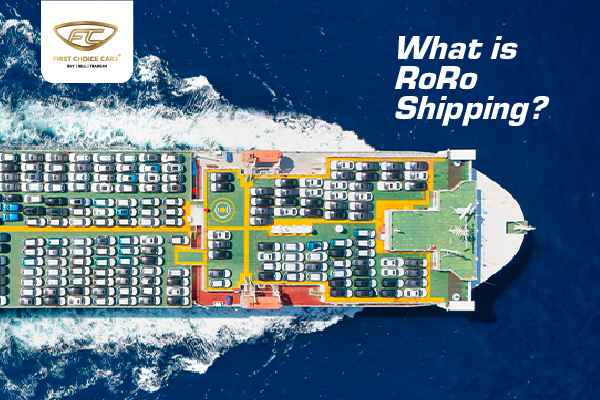
When people think of shipping cars, RoRo (Roll-on/Roll-off) is usually the first method that comes to mind. At the UAE port, cars are actually rolled onto the ship, and when they reach their destination, they are rolled off.
How does it work?
In a large floating garage, your car is driven onto a specially built RoRo vessel, secured in place, and then transported like cargo. It is driven away in the same condition after reaching the destination port.
Pros of RoRo
- It is more affordable than container shipping, which makes it perfect for large shipments.
- It offers quick loading and unloading, so the procedure is simple.
- Schedules: A lot of shipping lines run RoRo routes regularly.
Cons of RoRo
- Because cars are exposed to certain factors during RoRo shipping, including moisture, wind, and salt, they can cause damage.
- Only working cars are allowed to ship; if your car isn't able to drive, it can't go on RoRo.
- Offers less protection against theft or minor handling damage.
Best for: Fleet exports, standard cars in operational condition, or situations where cost is the primary consideration.
What is Container Shipping?
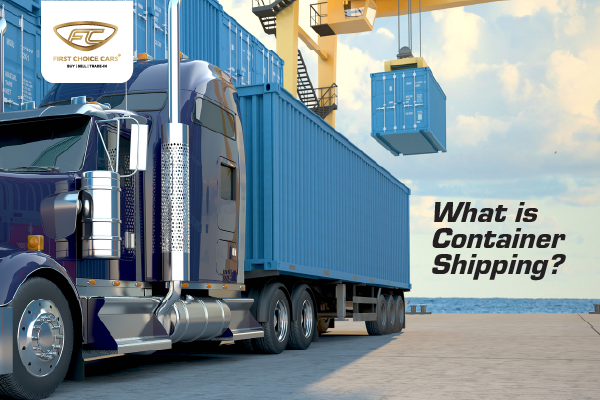
Your vehicle is safely packed into a steel container during container shipping. Exporters can select an option from the following based on their needs and budget:
How it Works
Vehicles are carefully loaded into 20ft or 40ft steel containers. Depending on needs, you can opt for a single-car container or a shared container. Single-car containers are ideal for expensive or delicate cars because they only hold one vehicle per box. Whereas multiple cars in a single container are known as shared containers, which divide expenses among shippers.
Pros of Container Shipping
- Maximum defence against theft, damage, and weather.
- Fits luxury models, vintage cars, and non-running automobiles.
- Permits the shipping of personal belongings, accessories, and replacement parts with the vehicle.
Cons of Container Shipping
- More expensive than RoRo shipping.
- Extra logistics are needed for loading and unloading.
- Extended wait times until the container is full may result from shared containers.
Best for: High-value vehicles, classic vintage cars, and vehicles that are damaged or non-functional.
Container vs. RoRo: Which One Wins?
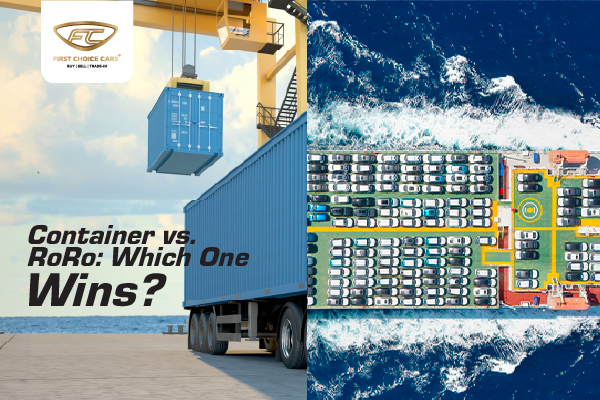
Choosing between RoRo and Container shipping depends on your priorities. Here’s a closer look at how both of them compare.
| Factor | RoRo | Container |
|---|---|---|
| Cost | Cheaper | More expensive |
| Protection | Minimal (exposed) | Maximum (sealed container) |
| Vehicle Type | Drivable, standard cars | Luxury, vintage, non-running |
| Transit Time | Often faster, frequent schedules | Depends on consolidation, but safe |
In simple terms, RoRo is ideal if you are shipping a Nissan Patrol or a Toyota Corolla in operational condition. Additionally, a container is well worth the money if you're moving a damaged SUV, a vintage Mustang, or a Bentley.
Factors to Consider Before Choosing
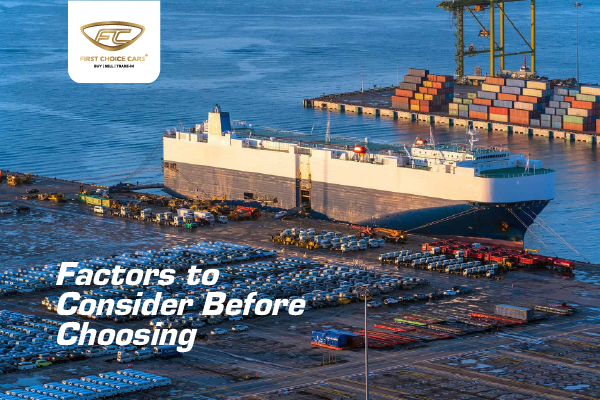
Every exporter has different needs depending on their budget, vehicle type, destination, and shipping priorities, so there’s no one-size-fits-all. Understanding what matters the most to you helps you make an informed decision. Still unsure? Consider these questions:
- How much is my car worth? The more expensive it is, the more you'll want a container for protection.
- Where is it heading? RoRo shipments are not accepted at every port.
- How quickly can I expect it to be shipped? Schedules for RoRo are typically more frequent.
- How much do I have to spend? Containers save peace of mind, and RoRo saves money.
- Is the vehicle moving? RoRo is off the table otherwise.
Consider all these factors to confidently decide which shipment method is best suited for your vehicle and destination.
Step-by-Step Car Export Process
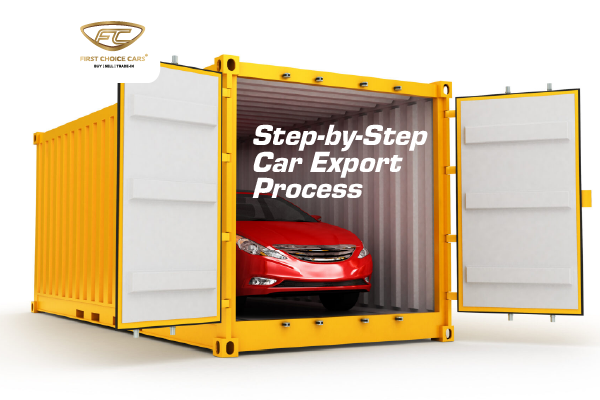
The process is actually simple once you know all the necessary steps, despite the fact that many first-time exporters believe it to be difficult. This is an example of a normal export:
- Obtain an export certificate from the RTA or relevant traffic authority.
- Choose your shipping method between RoRo or Container.
- Book a slot with a shipping line or agent.
- Clear customs at the UAE port.
- Load the vehicle onto the vessel.
- Transport the vehicle to the destination country.
- Clear customs upon arrival at the port.
- Deliver the car to the buyer or your chosen location.
By carefully following all these steps, you can ensure a smooth car export from the UAE to the desired location in a specific country.
Tips for a Smooth Export Experience
If you prepare in advance, the process of exporting cars from the UAE can go smoothly. The following are some useful tips to make the export process smooth:
- Work with licensed agents because skilled shippers are aware of how to prevent delays.
- Verify your documentation three times because incomplete paperwork may cause your shipment to be grounded.
- Obtain insurance, particularly for expensive vehicles.
- Be aware of the rules and regulations in the place you are visiting. Certain nations have severe import limitations.
If you want to buy or sell a car or used commercial vehicles, then First Choice Cars is a reliable platform in the UAE. They offer well-inspected used cars for sale, which are suitable for international shipments.
Conclusion
Exporting cars is now easier than ever before because of the UAE's excellent ports and effective logistics. Deciding between RoRo and container shipping is necessary when shipping a single car or a sizable fleet. Choose RoRo if you want to ship functional cars quickly and affordably, and choose container shipping if you want to export luxury, vintage, or damaged cars, and security is your top priority.
In the end, it's crucial to work with a reliable partner who can support you throughout the process and help you strike the best possible balance between cost, protection, and convenience. Your car won't just leave the port; it will reach its new home safely if you work with the right professionals.
Disclaimer: All information, including pricing, vehicle details, and legal requirements, is accurate at the time of publication but may be subject to change due to market conditions or policy updates. While First Choice Cars makes every effort to ensure the accuracy of the information provided, we hold no responsibility for any errors, omissions, or outdated content. We recommend contacting our team directly to confirm the latest details before making any decisions.
